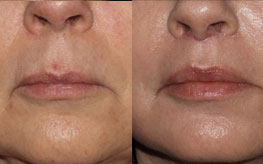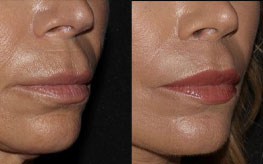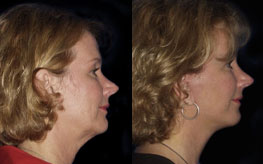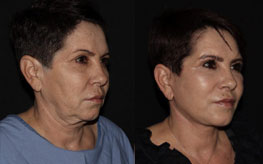Breast Enlargement & Lift
Conveniently located to serve the areas of San Diego, CA

Breast enlargement with lift (augmentation mastopexy) is a cosmetic procedure that accentuates your curves and restores balance to your body. Often women who have had children find that their breasts are both lower and smaller than before having children. Although a lift can restore fullness to the breast, often there is still a lack of upper breast fullness that requires augmentation with an implant at the same time. A breast enlargement with lift can restore the breast shape. When combined with a tummy tuck, this dual procedure is commonly called a “mommy makeover.”
Dr. John T. Alexander II has helped many patients enhance their curves with transformative breast procedures. If your breasts are sagging and losing volume, there is no need to wait to achieve your body goals. For more information about breast enlargement and lift procedures at Alexander Cosmetic Surgery, contact our office or call our San Diego location at (888) 463-9532.
Contents
- 1 About Breast Enlargement With Lift
- 2 Breast Enlargement With Lift Benefits
- 3 Candidates for a Breast Enlargement With Lift
- 4 Consultation
- 5 Personalizing Your Breast Implant With Lift
- 6 How to Prepare for a Breast Enlargement With Lift
- 7 Breast Enlargement With Lift Procedure
- 8 Breast Enlargement With Lift Recovery
- 9 Results of a Breast Enlargement With Lift
- 10 How Much Does a Breast Enlargement with Lift Cost in San Diego?
- 11 FAQ
- 12 References
About Breast Enlargement With Lift
Over time, a woman’s breasts can begin to lose firmness and fullness due to pregnancy, aging, or weight loss. A breast lift can restore youthful firmness, symmetry, and volume to drooping breasts by removing excess skin and tightening the surrounding tissue to reshape and support the new breast contour. We can enhance a breast lift through the simultaneous placement of breast implants, by performing a breast augmentation/lift, which creates even more fullness of the upper breast and is very effective for contouring your figure for your desired look. Approximately 35 million people have breast implants, (1) and in 2021, approximately 41% of breast procedures were breast augmentations. (2)
Incision
Surgeons make incisions to place the implants and to remove excess skin. We will discuss the best incision options based on your desired outcome, the position of your breasts, and the amount of skin we need to remove.
Implant Type
There are two types of implants, saline, and silicone. The outer covering (shell) of both implants is made of silicone.
- Saline breast implants are filled with sterile salt water. The implants come empty and are filled during surgery. They can be filled with varying amounts, which can affect the shape, firmness, and feel of the breast. Should the implant shell leak, a saline breast implant will collapse and the saline will be absorbed naturally by the body. Currently, saline breast implants are FDA-approved for augmentation in women 18 years of age and older.
- Silicone breast implants are filled with an elastic gel and are pre-filled by the manufacturer. The gel feels and moves much like natural breast tissue. If the implant leaks, the gel may remain within the implant shell, or may leak into the breast implant pocket, but will be contained by the scar tissue capsule, which forms around every implant.
A leaking implant filled with silicone gel does not collapse. If you choose these implants, you may need to visit your plastic surgeon regularly to make sure the implants are intact. An ultrasound or MRI screening can assess the condition of breast implants. Currently, silicone breast implants are FDA-approved for augmentation in women 22 years of age and older. Silicone implants may be recommended at a younger age if used for reconstruction purposes.
Silicone gummy-bear implants have a cohesive silicone gel inside that is more solid.
Position of Implant
Implants can be placed above the pectoralis muscle or below the muscle. Most often, implants are placed below the muscle to obtain better soft tissue coverage of the implant in the medial upper chest. Implants below the muscle preserve the most blood supply to the nipple-areola, making the procedure the safest.
Implant Size
We spend a great deal of time discussing size with patients. It is important to make sure that the surgeon and the patient are speaking the same language regarding size. By looking at photographs in magazines, before and after pictures, and discussing the patient’s desire for their overall look and proportion, we can come to a clear understanding of what each patient desires regarding size. It is more important to focus on the look than it is a specific implant volume.
Breast Enlargement With Lift Benefits
After a breast enlargement with a lift, you can enjoy fuller, lifted breasts that feel more comfortable in your bras. You can restore firmness, symmetry, and volume to previously droopy breasts by removing excess skin and tightening the surrounding tissue. The benefits of a breast lift include:
- Rounder, fuller breasts
- Enhanced breast shape and volume
- Increased breast size
- Improved self-esteem
- Symmetrical breasts
- Firmer breasts
The procedure is customizable to help you achieve your desired figure. The incision type, size of the implants, and type of implants used will determine your look.
Candidates for a Breast Enlargement With Lift
A woman’s breasts often change over time, losing their youthful shape and firmness. These changes and loss of skin elasticity can result from:
- Pregnancy
- Breastfeeding
- Weight fluctuations
- Aging
- Gravity
- Heredity
A breast enlargement-lift is an extremely effective procedure for reversing the effects of pregnancy and aging on the breasts. Patients who have undergone this procedure are generally thrilled with the improvements because they have regained the youthful look and feel of their breasts.
Consultation
To ensure the most natural-looking results, Dr. Alexander will recommend the procedure that most appropriately matches your needs and offer realistic expectations about post-surgery outcomes. Breast size and shape are important, so please be honest and open about your expectations when talking with your surgeon. Implant type and size will be determined not just on your desire but your breast anatomy, skin elasticity, and body type. The success and safety of your breast procedure depend very much on your being completely candid during your consultation. We will ask you questions about your health, desires, and lifestyle. Please be prepared to discuss:
- Why you want breast surgery, your expectations, and desired outcome
- Your willingness to accept scars to achieve a better shape
- Medical conditions, drug allergies, and medical treatments
- Current medications, vitamins, herbal supplements, alcohol, tobacco and drugs
- Previous surgeries
- Family history of breast cancer and results of mammograms or previous biopsies
We may also:
- Evaluate your general health status and any pre-existing health conditions or risk factors
- Examine your breasts and take detailed measurements of their size and shape, skin quality, and placement of the nipples
- Take photographs for your medical record
- Discuss your options and recommend a course of treatment
- Discuss likely outcomes of breast augmentation surgery and risks or potential complications
- Discuss anesthesia for your breast augmentation procedure
Personalizing Your Breast Implant With Lift
Your consultation will help your surgical team personalize your procedure for your desired look. There are four decisions to consider when preparing for this procedure: incision type, implant type, implant position, and implant size.
How to Prepare for a Breast Enlargement With Lift
To prepare for breast enlargement with lift, you will need to stop taking blood thinners 1-2 weeks before the procedure. You will also need to stop smoking approximately 6 weeks before. You will need someone to drive you to and from surgery and monitor your progress for 24 hours. We also recommend that you plan your meals ahead of time to prevent trips to the store during your recovery. Preparing will expedite your recovery and help your body heal.
Pre-Operative Appointment
Many patients also need a mammogram before surgery to ensure their breasts are in good health condition. You will need lab testing before your procedure. We will also schedule a post-operative physical to ensure you are recovering well.
Prior to surgery, we will have you do the following:
- Take certain medications or adjust your current medications
- Avoid taking aspirin, anti-inflammatory drugs, and herbal supplements as they can increase bleeding
- Stop smoking well in advance of surgery
- Depending on your age, get a baseline mammogram before surgery to detect any future changes in your breast tissue
During a preoperative appointment, usually 1-2 weeks before surgery, we will:
- Get lab testing or a medical evaluation
- Tell you what to do before surgery
- Discuss the use of anesthesia during your procedure
- Explain post-operative care and follow-up, and what help you will need after surgery
Breast Enlargement With Lift Procedure
The procedure typically takes about three hours depending on the individual and certain surgical variables. Medications are administered for your comfort during the surgical procedure. An anesthesiologist will administer general anesthesia, which is nearly always required for this procedure. There are nine basic steps to performing a breast augmentation-mastopexy.
Step 1 – Marking
While you are sitting up, Dr. Alexander will make careful measurements and markings on the breast. This is arguably the most important part of the procedure, and requires skill, patience, experience, and a good eye for symmetry and detail.
Step 2 – The incision
Dr. Alexander will make an incision around the areola, often reducing the diameter. The incision is carried through the skin, down to the pectoralis muscle, which covers the anterior chest wall.
Step 3 – Creating the pocket
Dr. Alexander will make a space for the implant, usually under the pectoralis muscle.
Step 4 – Determining the right size of implant
Dr. Alexander will use a temporary saline-filled sizer to determine which size implant you need. He can add saline to determine which range of volume will give the desired appearance.
Step 5 – Placing the implant
Dr. Alexander will wash the pocket with saline and an antibiotic solution. He will position the implant correctly in the pocket and sit the patient up to check for symmetry. He will make minor adjustments as necessary to make the breasts as symmetrical as possible.
Step 6 – Re-marking the breast
With the implants in place, he will recheck the breast marks to make sure that the skin to be removed is accurately indicated.
Step 7 – The skin incisions
There are three common incision patterns, depending on how low the breast sits and how much skin needs to be removed:
- Around the areola. This is called a ‘periareolar’ or ‘donut’ mastopexy.
- Around the areola and vertically down from the areola to the breast crease, often referred to as a ‘vertical’ mastopexy, because it requires a vertical line. Patients often worry about this incision, but it actually heals extremely well.
- Around the areola, vertically down from the breast crease, and horizontally along the breast crease. This is often called an ‘anchor incision’ or ‘inverted T.’
Step 8 – Reshaping the breasts
If necessary, Dr. Alexander can reduce enlarged areolas by excising skin at the perimeter. He then lifts and reshapes the underlying breast tissue to improve breast contour and firmness. He layers sutures deep within the breast tissue to create and support the newly shaped breasts. After repositioning the nipple and areola to a natural, more youthful height, he removes excess breast skin to compensate for a loss of elasticity.
Step 9 – Closing the incisions
After Dr. Alexander reshapes your breasts and removes excess skin, he will tighten the remaining skin and close the incisions with sutures. No drains are needed. Some incision lines resulting from breast lift are concealed in the natural breast contours; however, others are visible on the breast surface. Incision lines are permanent, but in most cases will fade and significantly improve over time.
Breast Enlargement With Lift Recovery
After your procedure is completed, we will wrap your chest with a snug bandage. This may feel increasingly tight during the night because of swelling, but we will loosen it the next day. Usually, you will remain wrapped for 48 hours, after which you can remove the wrap, take a cool shower, and place a soft bra, which we provide, for support. You will need someone to drive you to and from surgery and to stay with you for at least the first night following surgery. If you experience shortness of breath, chest pains, or unusual heartbeats, you should call your surgeon immediately.
You will likely need a recovery period of 24 to 48 hours and an additional reduced-activity period of a few days. You will experience soreness and swelling for a few weeks. Exercise and normal activity can resume at approximately 2-3 weeks. Over time, post-surgical swelling will decrease and incision lines will fade.
The practice of medicine and surgery is not an exact science. Although we expect good results, there is no guarantee. In some situations, it may not be possible to achieve optimal results with a single surgical procedure and another surgery may be necessary.
It is important to know that after receiving breast implants, results are long-lasting but not permanent and they may require replacement during your lifetime. Over time, your breasts can change from aging, weight fluctuations, hormonal factors, and gravity. You should expect to have future visits with us to discuss changes in your breasts.
Results of a Breast Enlargement With Lift

Patients who have undergone this procedure at our practice are very satisfied with their new breasts. Many times breast implants give women the voluptuous, symmetrical curves they have always wanted, but were unable to achieve without surgery.
Sutures are removed beginning at 3-4 days and finally at 10-14 days. Removable sutures are used to minimize scarring. Absorbable sutures can increase inflammation and increase scarring. The improved shape of the breasts will be visible immediately, but the lower part of the breast is often temporarily tight and flat. The final results of your breast lift will appear over the next few months as breast shape and position continue to settle. Incision lines are permanent but will continue to fade over time.
The results of your breast lift surgery will be long-lasting. You will find it easier to wear certain styles of clothing and swimsuits. Like most women who have had this breast procedure, you may also have a boost in self-confidence. Over time, your breasts can continue to change due to aging and gravity. But, you will be able to retain your new look longer if you maintain your weight and keep a healthy lifestyle.
Special note: While a breast lift does not usually affect breast function, if you are planning to become pregnant, discuss this with Dr. Alexander. Changes that occur in the breasts during pregnancy can minimize or reverse the improvement a breast lift provides. Likewise, plans for significant weight loss should also be discussed.
How Much Does a Breast Enlargement with Lift Cost in San Diego?
The cost of your procedure will depend on the treatment area. We will provide an all-inclusive quote after your consultation. Why wait to enjoy your dream body? Contact our office to learn more about how we can help you meet your body goals and schedule a consultation. The costs include:
- Surgeon’s fee
- Implant cost
- Operating room and supplies
- Prescriptions for medication
- Medical tests
- Anesthesia fees
FAQ
Are there any risks with a breast enlargement lift?
With any surgery, there is a risk of scarring and infection. Some patients experience hardening of the breast tissue (capsular contraction) after the procedure. During your consultation, we will discuss your personal risk factors to determine whether or not this is the best procedure to help you meet your body goals. Breast implants can also affect breastfeeding.
Will I need more than one breast enlargement lift procedure?
You may need an additional procedure if changes to your body from age cause your skin to sag. It’s important to know that after receiving breast implants, results are not permanent and they may require replacement during your lifetime. Over time, your breasts can change due to aging, weight fluctuations, hormonal factors, and gravity. You should expect to have future visits with us to discuss changes in your breasts.
Does a breast enlargement lift affect breast function?
The procedure does not affect breast function, but if you are planning to become pregnant, some women have trouble breastfeeding after the procedure. Pregnancy also changes your breasts which can affect the results of your procedure. During your consultation, we can discuss your family planning.
References
- Aitzetmüller-Klietz, Marie-Luise, et al. “Complication Rates after Breast Surgery with the Motiva Smooth Silk Surface Silicone Gel Implants—a Systematic Review and Meta-Analysis.” Journal of Clinical Medicine, vol. 12, no. 5, 1 Jan. 2023, p. 1881, www.mdpi.com/2077-0383/12/5/1881, https://doi.org/10.3390/jcm12051881. Accessed 28 Mar. 2023.
- Medor, Maria C., et al. “How Big Is Too Big? Exploring the Relationship between Breast Implant Volume and Postoperative Complication Rates in Primary Breast Augmentations.” Plastic and Reconstructive Surgery – Global Open, vol. 11, no. 3, Mar. 2023, p. e4843, https://doi.org/10.1097/gox.0000000000004843. Accessed 10 Apr. 2023.
- Spencer, Linda, et al. “The Relationship between Breast Size and Aspects of Health and Psychological Wellbeing in Mature-Aged Women.” Women’s Health, vol. 16, 18 May 2020, p. 1745506520918335, www.ncbi.nlm.nih.gov/pmc/articles/PMC7235664/, https://doi.org/10.1177/1745506520918335. Accessed 11 Jan. 2022.





